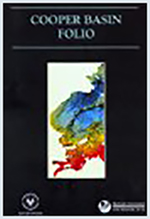On this page
Cooper Basin 3D Model
Geoscience Australia in collaboration with the Department for Energy and Mining and the Geological Survey of Queensland has developed a 3D basin model, characterising regional basin architecture, has been constructed through the integration of existing horizons with formation tops and seismic interpretations.
For more information: Geoscience Australia - Cooper Basin Prospectivity Study
To download the model: Cooper Basin Regional Petroleum Systems Model
Cooper Basin Electro-facies Mapping Project (2004)
Wireline logs from approximately 830 wells were analysed using in-house script known as ElectroFacies. Preset cut-off values were used to analyse the thickness and percentage of electrofacies for the following formations of the Cooper Basin sequence: Patchawarra, Epsilon, Daralingie, Toolachee and Nappamerri Formations. A series of isolith and isopach maps, first produced in 1998 by McLean and Hill, have been further developed by X. Sun and B. Camac (2004) to include recent data and specifically correct anomalous readings. These maps have been produced for sandstone, silty or muddy sandstone, shale/siltstone and coal for the formations analysed. These are intended to provide a general guide for interpretation of Cooper Basin lithofacies distribution and palaeogeography, leading to improved prediction of reservoir, source and seal rocks.
Read the final report via SARIG: Cooper Basin Electrofacies Mapping Project South Australia (X. Sun and B. Camac, 2004)
Warburton Basin GIS Data Atlas (2001)
Rod Boucher (Linex Pty Ltd) was commissioned by the department using Targeted Exploration Initiative SA funding to bring together Warburton Basin research concepts and data into a comprehensive atlas. This atlas incorporates existing petroleum databases including:
- relevant reports in pdf format
- scanned core photographs
- scanned composite logs
- excerpts from scanned well completion reports
- scanned seismic lines
- spreadsheets of formation tops
- digital thin section images
ArcExplorerGIS projects are also included, with subcrop maps, tectonic and magnetic interpretations, wells, petroleum shows and tenements so key data are readily accessible via GIS front ends.
The dataset aims to provide company geologists and mud loggers in an office or mud logging truck on a wellsite with sufficient information to quickly and accurately identify Warburton Basin rock units.
Two methods were used to display the data in the atlas. A GIS interface was used wherever possible to compile the report. Many images were compiled in PDF format, but the zip file contains shape files for import into the customers GIS package.
Cooper Basin folio
 This folio was the culmination of an extensive seismic mapping and interpretation of the Cooper and Eromanga Basins, South Australia that commenced in 1995. Three key horizons C, P (Top Permian) and Z (Basement) are mapped in both time and depth using open file company data.
This folio was the culmination of an extensive seismic mapping and interpretation of the Cooper and Eromanga Basins, South Australia that commenced in 1995. Three key horizons C, P (Top Permian) and Z (Basement) are mapped in both time and depth using open file company data.
The resulting data was initially presented in two volumes. These have since been merged into a single PDF.
- Volume 1- Seismic Maps; contains key seismic depth structure maps, formation isopachs and structural elements.
- Volume 2 - Geological Maps; contains the geological datasets including lithofacies mapping, maturity maps of key source intervals, depths to oil and gas windows and gas wetness maps.
Download the PDF containing both volumes from SARIG: Cooper Basin folio: Volumes 1 and 2.
All data are also available in digital format and are supplemented by individual technical reports available from Energy Resources Division email DEM.petroleum@sa.gov.au


